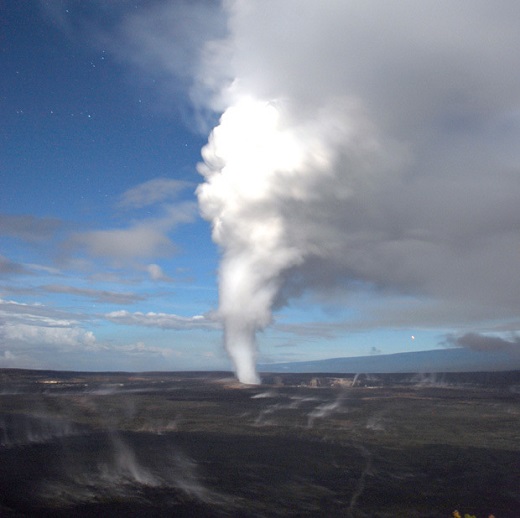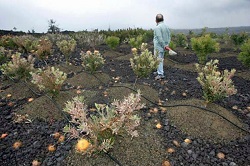EARTH SCIENCES
Businger models vog for Hawai'i

A paper published this month by University of Hawaiʻi and Hawaiian Volcano Observatory researchers in the Bulletin of the American Meteorological Society details the development and utility of a supercomputer model for the dispersion of volcanic smog or “vog,” which forms when volcanic sulfur dioxide gas interacts with water and coverts it to acid sulfate aerosol particles in the atmosphere.
Vog poses a serious threat to the health of Hawaiʻi’s people as well as being harmful to the state’s ecosystems and agriculture. Even at the low concentrations, which can be found far from the volcano, vog can provoke asthma attacks in those with prior respiratory conditions. It also damages vegetation and crops downwind from the volcano.
News tools for predicting vog
Scientists from the UH Mānoa School of Ocean and Earth Science and Technology (SOEST), under the leadership of Professor of Meteorology Steve Businger, and in collaboration with researchers at the Hawaiian Volcano Observatory, developed a supercomputer model for predicting the dispersion of vog. The vog model uses measurements of the amount of sulfur dioxide (SO2) emitted by Kīlauea, along with predictions of the prevailing winds, to forecast the movement of vog around the state.
The team of scientists developed an ultraviolet spectrometer array to provide near-real-time volcanic gas emission rate measurements; developed and deployed SO2 and meteorological sensors to record the extent of Kīlauea’s gas plume (for model verification); and developed web-based tools to share observations and model forecasts, providing useful information for safety officials and the public and raising awareness of the potential hazards of volcanic emissions to respiratory health, agriculture and general aviation.
“Comparisons between the model output and vog observations show what users of the vog model forecasts have already guessed—that online model data and maps depicting the future location and dispersion of the vog plume over time are sufficiently accurate to provide very useful guidance, especially to those who suffer allergies or respiratory conditions that make them sensitive to vog,” said Businger.
A statewide concern
Kīlauea volcano, the most active volcano on earth, is situated in the populous State of Hawaiʻi. The current eruption has been ongoing since 1983, while a new summit eruption began in 2008.
The most significant effect of this new eruption has been a dramatic increase in the amount of volcanic gas that is emitted into Hawaiʻi’s atmosphere. While the effects of lava eruption are limited to the southeastern sector of the Big Island, the volcanic gas emitted by Kīlauea is in no way constrained; it is free to spread across the entire state. 
“Higher gas fluxes from Kīlauea appear to be the new norm. For the State of Hawaiʻi to understand the effects of vog and then come up with strategies to efficiently mitigate its effects, accurate forecasts of how vog moves around the state are vital,” said Businger.
The American Recovery Act award that originally funded the development of the vog model program has long since expired. Funding for a PhD candidate, Andre Pattantyus, to help keep the online vog products available has been provided by SOEST and the Joint Institute for Marine and Atmospheric Research.
Because Pattantyus, the lead vog modeler, is set to graduate this winter, the vog program is at a crossroads. Businger is working with stakeholders that include federal, state, commercial and private interests to jointly fund an ongoing vog and dispersion modeling capability for the residents of Hawaiʻi.
Public support of the vog modeling program is critical for the program to continue providing vog plume predictions in future.
